Build a Simple State Machine
To build a state chart, you first build a simple state machine.
Click Add State
 in the State Chart Tools
toolbar, then click a spot in the editor where you want to place the
new state. It is created in the chart with a double circle: the first
state created in a graph is initial. You can change this, and the state
properties by double-clicking it: in the State Chart Tools
toolbar, then click a spot in the editor where you want to place the
new state. It is created in the chart with a double circle: the first
state created in a graph is initial. You can change this, and the state
properties by double-clicking it:
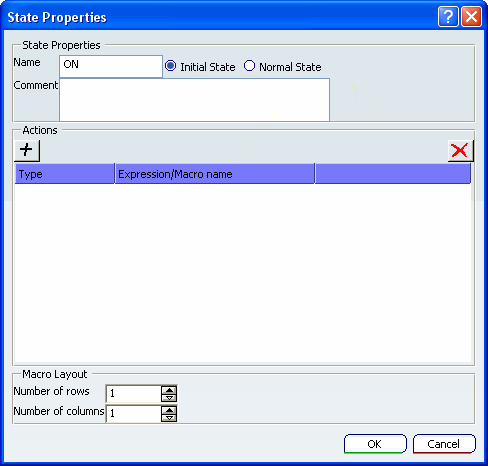
Add a second state in the chart, to represent the mode
OFF. The chart displays a warning at this step of the construction
because one state is not linked by a transition:

Add actions to a state in the properties window of the
state by clicking on the + sign.
The image below shows how to associate the action of setting the signal
heating_on to false with the state OFF:
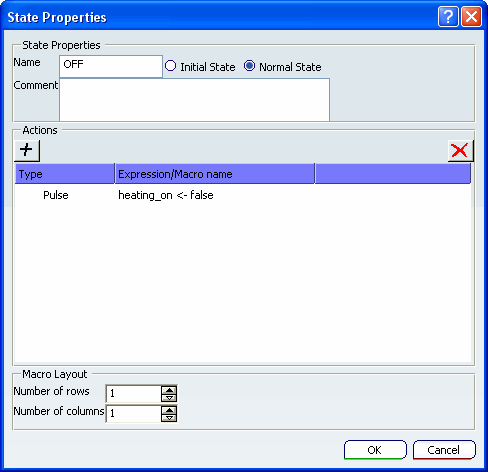
Click OK. A state with an associated action is represented
like this:
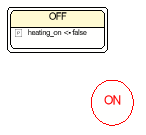
If you repeat this procedure for the other state, you
get the following result:
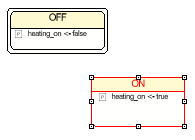
To add transitions between the two states, click
Add Transition
 in the State Chart
Tools toolbar. Select the source state in the chart, then the
target state. This results in the following: in the State Chart
Tools toolbar. Select the source state in the chart, then the
target state. This results in the following:
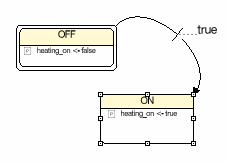
The default condition for a transition is the expression
true. Conditions on transitions belong to the property of the transition.
To change them, double-click on the transition, and enter the Boolean
expression you need for the condition:
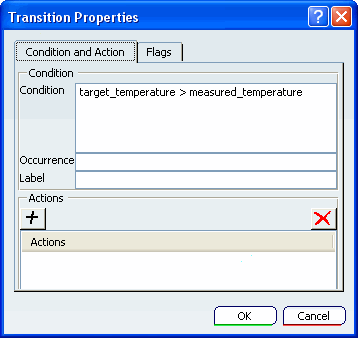
You can also set flags for the transition, by clicking
on the Flags tab. These flags are the same as the ones used
in the SFC+ formalism, you can refer to their definitions in
Sequential Function Chart (SFC+).
Once completed, the state machine looks like this, and
can be simulated.
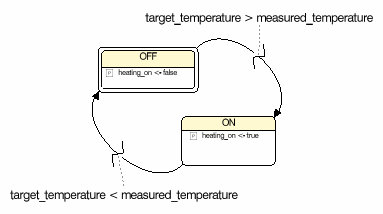
You can change the layout of a transition. Select a
transition, five handlers appear: two at the transition extremities
(green squares), two on the transition and one on the condition text.
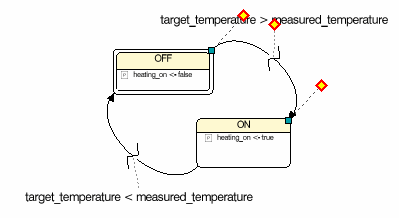
The two extremity handlers are used to connect and disconnect
the transition to a state. When the two extremities are connected, handlers
appear in green (like in the picture above). The image below is the
same chart with the link unconnected. The handler is red, the state
ON is red as well because it has no incoming transition:
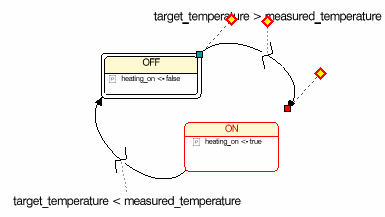
The two orange handlers are used to change the curve:
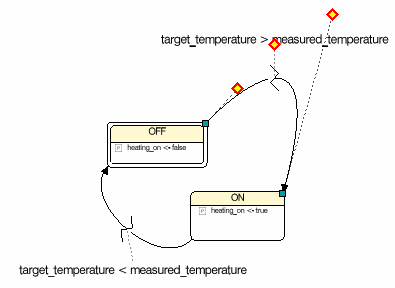
The handler of the condition text is used to move the
text:
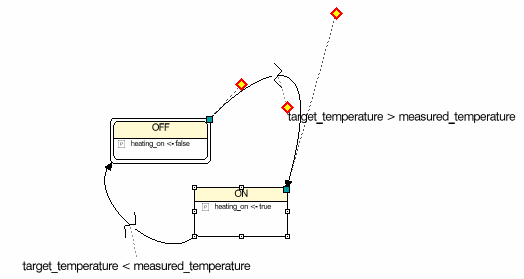

Use Hierarchy by Running and Pre-empting a
Block Instance
Once the block is created, you can use the hierarchy by running and pre-empting a block instance.
More specifically, the THERMOSTAT block is ready. Now you are going to use and
trigger the thermostat inside the behavior of the heating controller.
Create a new State Chart block named HEATING CONTROLLER
.
Declare one instance of the block THERMOSTAT
in the HEATING CONTROLLER block.
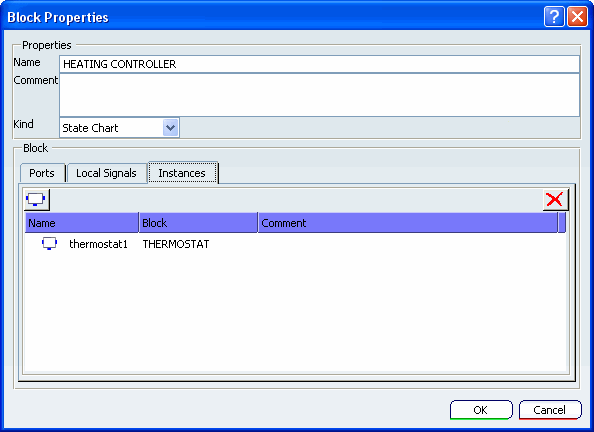
Open the State Chart Editor for the block HEATING
CONTROLLER, and run the instance thermostat1 in the state
ON. To do this, display the properties of the ON state
and add an action by clicking on the + sign. Select Run from
the action types list:
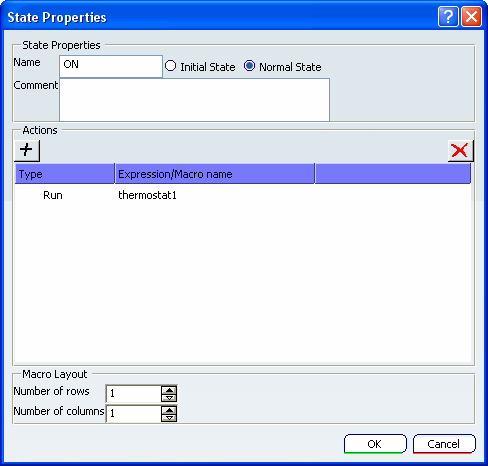
Click OK: your chart now looks like this:
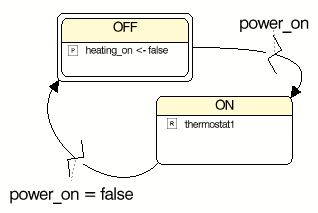
This means the following:
-
When run, the block HEATING CONTROLLER
starts emitting the signal heating_on with the
value false. When the input power_on has the value true,
the state OFF is de-activated and the state
ON is activated. The instance thermostat1
is run.
-
When the input power_on is set
to false, the state ON is deactivated, thus the
instance thermostat1 is killed.
You can get more details on how this specification works
cycle-by-cycle according to input changes (especially with transition
flags choices) in
Sequential Function Chart (SFC+).
Note: You can run as many block instances as you want
within a state. When the state is active, they are all run in parallel.

Use a Hierarchy with a Macro
Instead of running a block, you can design behavior by using a macro.
You can design the previous behavior with the same specification
by using a macro instead of running a block instance. This is useful
if you don't need to reuse the code of the macro (a macro is a piece
of behavior that is not reusable), and might in some cases, enhance
readability of a chart.
Add a macro action in the state
ON by editing its properties and adding an action type macro, then click OK.
Note:
The name of the macro is optional.
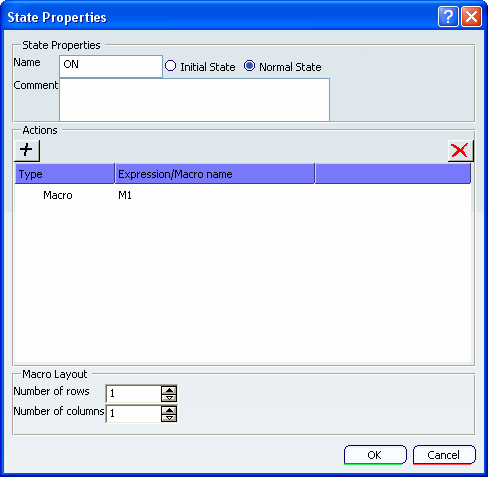
Author the macro state by editing it: double-click
on the macro area in the state representation.
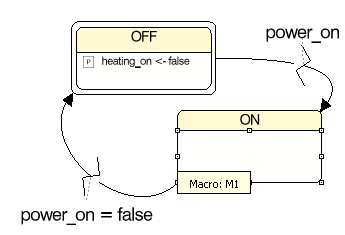
You are now in a blank page, and you can build the macro.
Here is how a state machine looks with a macro:
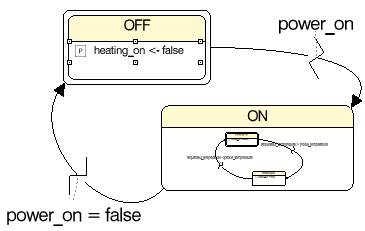
Note: You can add as many macros as you want within
a state. When the state is active, they are all executed in parallel.
Here is how the previous graph would look with two macros
in the state ON:
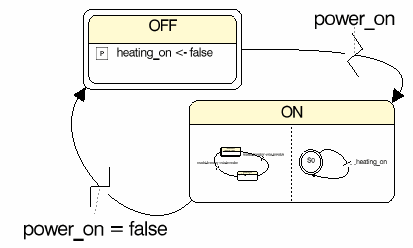

Associate Actions on Transitions
You can associate simple actions (that is, a simple
signal emission: a pulse action) to transitions.
Double-click
on a transition to edit its properties, and add an action in the Actions
area:
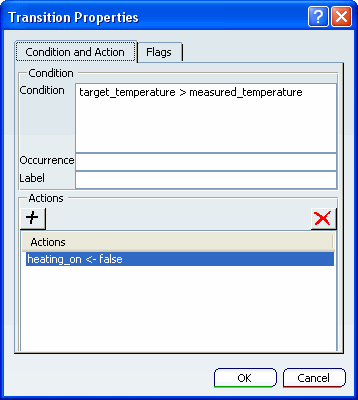
Click OK to set the properties. Conditions
and actions are separated by a slash in the chart. Below is another
way to represent the block THERMOSTAT with actions on transitions:
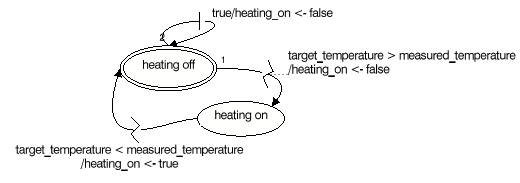
|
![]()
![]()




















